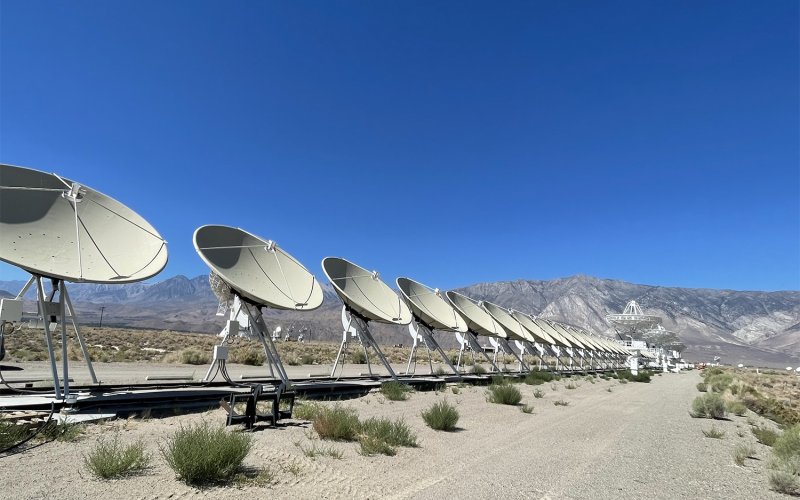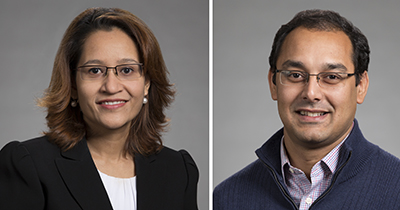Project Aims to Overcome Signal Interference in Radio Astronomy

ALBANY, N.Y. (Oct. 27, 2022) — Producing startling images of distant galaxies, black holes and exoplanets, radio telescopes open a window into the furthest reaches of the universe. But with competition from smartphones, car radios, microwaves and a multitude of devices across the electromagnetic spectrum, radio telescopes face increased interference while attempting to collect data. Accounting for these external signals is even more challenging when the sources of the interference are mobile and space- or airborne, like airplanes, satellites and unmanned aerial vehicles (UAVs).
Now, a new project led by researchers at the University at Albany in collaboration with Caltech Astronomy aims to address the challenges created by increased radio interference from airborne transmitters by deploying a reconfigurable intelligent surface (RIS) near a radio telescope to mitigate the impact that other users of the electromagnetic spectrum have on astronomical observations.
Supported by a $634,799 3-year grant from the National Science Foundation (NSF), UAlbany researchers and assistant professors Dola Saha and Aveek Dutta have started working on this project, named “SCISRS: Signal Cancellation using Intelligent Surfaces for Radio Astronomy Services.”
The primary objective of this project is to accurately track the mobile interfering sources, estimate the amount of incident Radio Frequency Interference (RFI) on the radio telescope, and then develop an RIS that can reflect incoming RFI signals towards the telescope in such a way that the reflected RFI cancels out the direct RFI when the two signals combine in the telescope receiver.
“While radio telescopes are often built in remote locations, the areas in which they are located are now experiencing ongoing increases in population density, increased numbers of low Earth orbiting satellites,” said Saha, principal investigator and an assistant professor of Electrical and Computer Engineering at UAlbany’s College of Engineering and Applied Sciences (CEAS). “Improving the ability to remove RFI from astronomical observations helps preserve the value of the investment in these expensive instruments and helps ensure their continued scientific capability.”
“This research will benefit not only the scientific community, but also the general public — and it is a great example of AI at Albany," said said College of Engineering and Applied Sciences Dean Michele J. Grimm. "Using a neural networks approach within AI, the systems that Saha and Dutta will develop will improve the images that we can obtain from radio telescopes while also reducing some of the restrictions that are in place related to the use of the wireless spectrum by telecommunications systems and the Internet of Things."
The project will construct an experimental radio telescope at UAlbany using over-the-shelf parts available to purchase. The cancellation approach will be tested on the UAlbany’s Radio Telescope and at the NSF-funded Deep Synoptic Array-110 (DSA-110) telescope array at the Owens Valley Radio Observatory (OVRO).
“The primary technical objectives of this project are to accurately estimate the RFI incident at the telescope and to configure the RIS so the reflected signal arriving at the telescope receiver precisely cancels the incident RFI,” said Dutta, co-principal investigator and an assistant professor of Electrical and Computer Engineering. “Cancellation requires control over both amplitude and phase of the reflected signal, which is achieved by tuning the reflecting elements of the intelligent surface.”
A key challenge tackled in the research is to cancel mobile RFI sources such as airplanes and satellites. Mobile sources stress the ability of the RIS controller to keep up with changes in the direction of RFI and the controller’s ability to keep the surface tuned precisely enough to cancel the RFI.
The project combines three areas of innovation to overcome this challenge.
At the system level, the RIS controller uses feedback from the telescope, which continually reports the residual RFI it sees, to compensate for estimation errors. At the algorithm level, a novel, low-complexity multi-stage direction of arrival estimation method is combined with an adaptive beamforming algorithm that shapes and steers the reflected RFI. At the hardware level, a 16-channel high-speed processing platform built from Field Programmable Gate Arrays is coupled with a custom fabricated RIS to enable real time RFI estimation and adaptive beamforming.
The platform and tools developed in this project will be incorporated into graduate and undergraduate courses at UAlbany as well as a summer school at OVRO. Wireless signals and other datasets captured from the testbed will be made available to the larger community to foster practical research in this field.
The University recently launched the Albany Artificial Intelligence Supercomputing Initiative (Albany AI), a $200 million public-private endeavor that will empower university and industry researchers to harness massive data sets to better understand how to automate complex operations like diagnosing and treating disease and forecasting natural disasters.
CEAS will play a central role in the development of Albany AI, which includes renovation of the Former Albany High School, an iconic 110-year-old neo-classical building on the University’s Downtown Campus, that will serve as the college’s home. UAlbany will also build a new supercomputing cluster housed in the Data Center on UAlbany's Uptown Campus with the goal of becoming first university-based computer to reach a quintillion computations per second.





